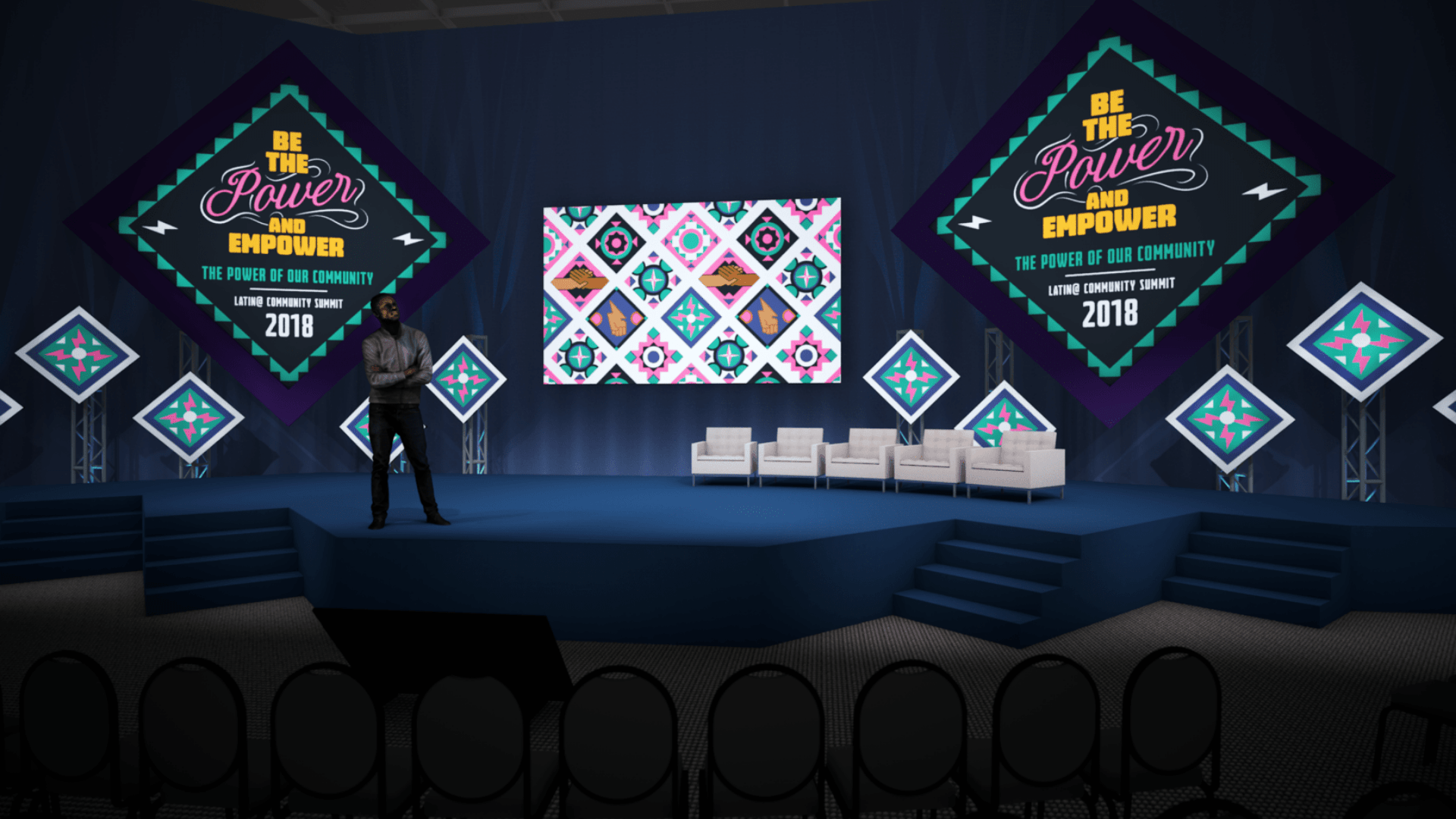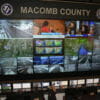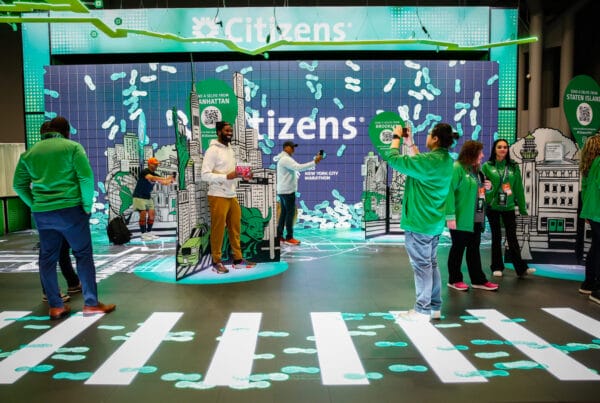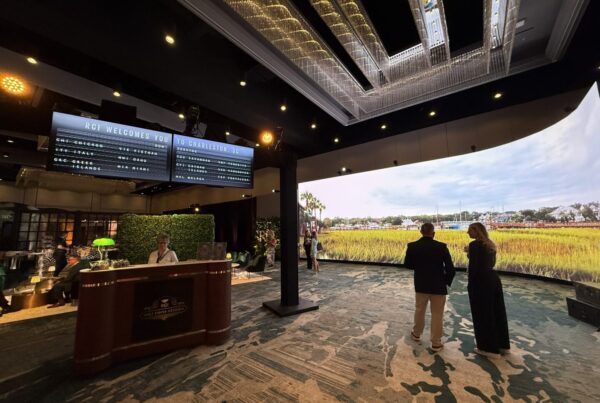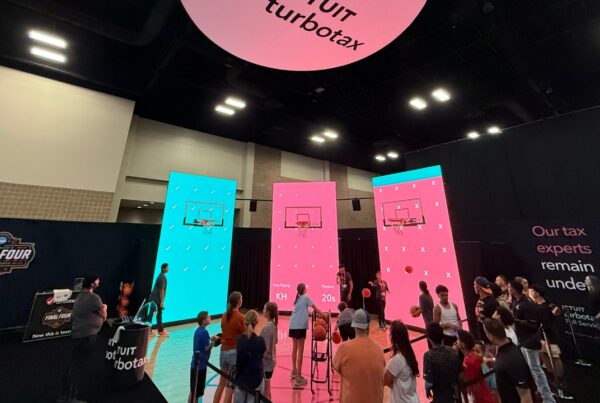As businesses prepare for the re-entry of employees and customers, many are wondering how they can effectively communicate their message to larger groups through meetings and events. While an individual business may have a strong plan in place to safely return its staff to work, there will still be health guidelines to keep in mind for assembling large groups.

Most businesses are feeling the pressure right now that “business must go on,” understanding it needs to be done in a different way than we’re used to. It’s no different for large meetings and events where you have an important message to get out – customer communication, press announcements, product releases, training sessions, employee alignment meetings, town halls, etc. While we may soon be ready to re-enter the workforce or go out to dinner, it will be a slower transition into gathering in larger groups. And regardless of what the health guidelines say, some people will still feel tentative which can impact participation. A few months ago, we may have mandated that employees attend all company meetings in person, or that a customer event or training happened in a convention hall. For the foreseeable future, having a virtual access option will be a must have.
So, what will your meetings and events look like in the coming months? This will first depend on health guidelines from the Centers for Disease Control (CDC) and World Health Organization (WHO), but also what your company and your attendee audience is comfortable with. To help you think through your own plans, following are what we’ve defined as The Four Phases of Meeting and Event Re-Entry.
Phase One: Very Small Groups in One Location
Event Type: Virtual only meetings
This is essentially where we are now, as of early May 2020. The CDC has provided guidance that there should be no groups larger than 10-people. Social distancing rules are in place, recommending that we all remain at least 6-feet apart, and most businesses have policies that any sort of travel should be for essential purposes only.
Considering you can only have 10-people in one room, the only option here is to run a meeting virtually, meaning your audience will be viewing over online video. Meetings like this don’t only need to be done as a Zoom or GoToMeeting video call. They can also have strong production value either by combining a video broadcast with a creative wrapper and strong audio, or be broadcast out of a studio with high quality video cameras, LED screens in the background, and a local production crew. In the latter scenario, the studio set can be managed with less than 10-people present and plenty of space between everyone involved.
Phase Two: Gatherings up to 50 People
Event type: Small groups in separate locations, with virtual meeting for larger audience
At some point the CDC will modify its guidance to allow for larger gatherings, but will likely advise to keep the groups smaller. Once we get here, my prediction is that the CDC may not specify how big the group can be, but will just say that social distancing rules need to remain in place. Many companies may feel okay getting people together, but let’s assume most won’t want to gather groups larger than 50 people.
If you do pull a group together that has 50 people, you will need to ensure it’s in a room that allows each person to remain at least 6-feet apart. In normal times, a meeting room with tables has a capacity based on a measurement of 12 square feet per person, and if it’s auditorium seating, that capacity will be based on only 8 square feet per person. To remain 6 feet apart, that would mean your calculation would change to 36 square feet per person, which necessitates a meeting room to be 3 times larger than you would normally require, and with auditorium type seating you need a space that is almost 5 times larger. Yes that’s right – if you have 50 people that you want in auditorium style seating, you would need to reserve a space that can normally accommodate 250 to allow everyone to keep their distance. If you want to be extra cautious because people are sitting in the same room for hours at a time, you may even want to go for a 500-person auditorium.
But we all know that 50 people isn’t your total audience – you need to reach far more people. Those 50 people will add excitement and energy into a room, which is a big part of what makes a larger meeting so engaging. So in this phase, you can have very high production value on your main stage, and your larger audience can be in other 50 person auditoriums watching over a video broadcast or watching from their home office or workplace.
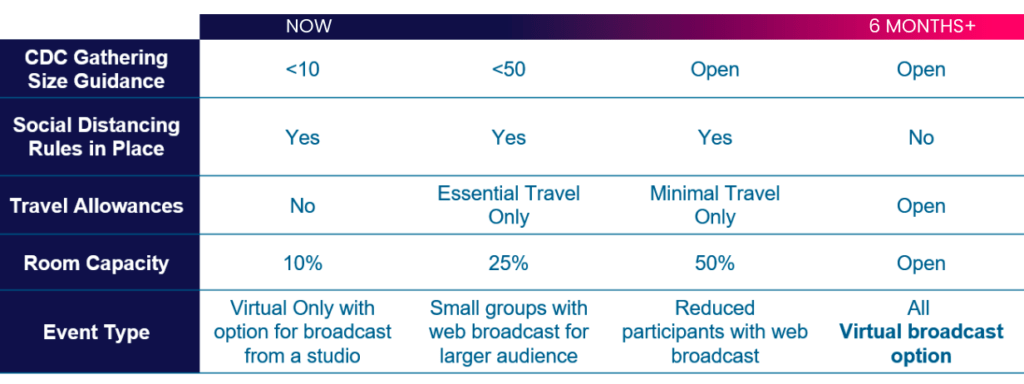
Phase Three: Cautiously Normal
Event Type: Large gathering with strong virtual access
This will be the phase that we are historically familiar with when other viruses have been out there in the past. Many people are hesitant and have their antennas up to avoid anyone who is sick and to keep their hands clean. In this phase, COVID-19 is still out there, but it’s largely been controlled as we have more data on how it’s spreading and how to stay safe.
Here we will simply be advised to “be careful,” and company policies will start opening up a bit to go ahead and travel, but to keep it to a minimum when possible. While we may not see social distancing rules as strictly enforced, it’s pretty much how everyone will continue operating.
When it comes to a larger meeting, while people are more comfortable getting out into the world, they’re still hesitant to be in very large crowds. In order to ensure people feel comfortable, companies will still be using venues that are much larger than what would typically be used so that people can keep their distance.
So here we have a reduced number of participants in a single location, and at least half of the total audience will be participating virtually in some capacity. The local production value will continue to improve, as will the energy in any given room, which will further make that virtual experience even better.
Phase Four: New Normal
Event Type: Altered version of the new live event
This is the phase we’re so looking forward to when we have largely put COVID-19 behind us with vaccinations available and it being something you can relatively easily avoid. However, today most everyone is going through the realization that this pandemic is likely changing our social behaviors in ways that may never go away.
When we get to this phase, full scale meetings and events will be back. While in many ways they may feel like “normal” again, when we look around, we’ll observe several things that mostly didn’t exist before – larger room spaces, less handshaking, and a lot more hand sanitizer.
This idea of virtual events isn’t new as of April 2020, as it’s been around for a while, but it’s sure getting more attention and becoming more important. Once we get to this New Normal phase, virtual events will continue to exist because so many will realize how impactful they really can be. This will lower the barrier to entry for smaller companies that want to run events without the expense of the venue and travel and will allow larger events to reach even more people.
Check back for additional content in our series regarding virtual events and the role they will play in gradually moving the event space back to in-person events. In the short-term it’s likely best in many cases to transform your meeting into a virtual event. Bluewater can provide strategic consulting in making the transition to one of the 3 main types of virtual events and ultimately produce your virtual meeting. If you’d like more information, please contact us today and we’d be happy to discuss your event!


